Special Report: The State of Digital & Search Engine Marketing in Luxury Industry

Executive Summary
With the rise of the internet and web technology, marketing strategies have transformed drastically to adapt and evolve with the consumers’ digital consumption and behaviour. Luxury advertisers have diversified their media and marketing mix over the recent years, tackling the challenges of digital marketing.
According to Nielsen1, it is identified that three out of the five top most valuable online properties are search engines. In addition, the new features rolled out by Facebook such as Graph search and YouTube’s addition of ‘semantic search’ technologies which allow users to search and look for information in a relevant and contextual manner simply highlight the importance of search engine marketing.
In the PM Digital 2012 research study2, it can be found that in North America for luxury apparel and accessories brands, Search engines have continued to be the largest source of web traffic to luxury brand sites (37% of clicks traffic).
Google Trends tool briefly illustrates the rise in users’ interest towards luxury brands on the search engine over the last 4 years (as shown below).
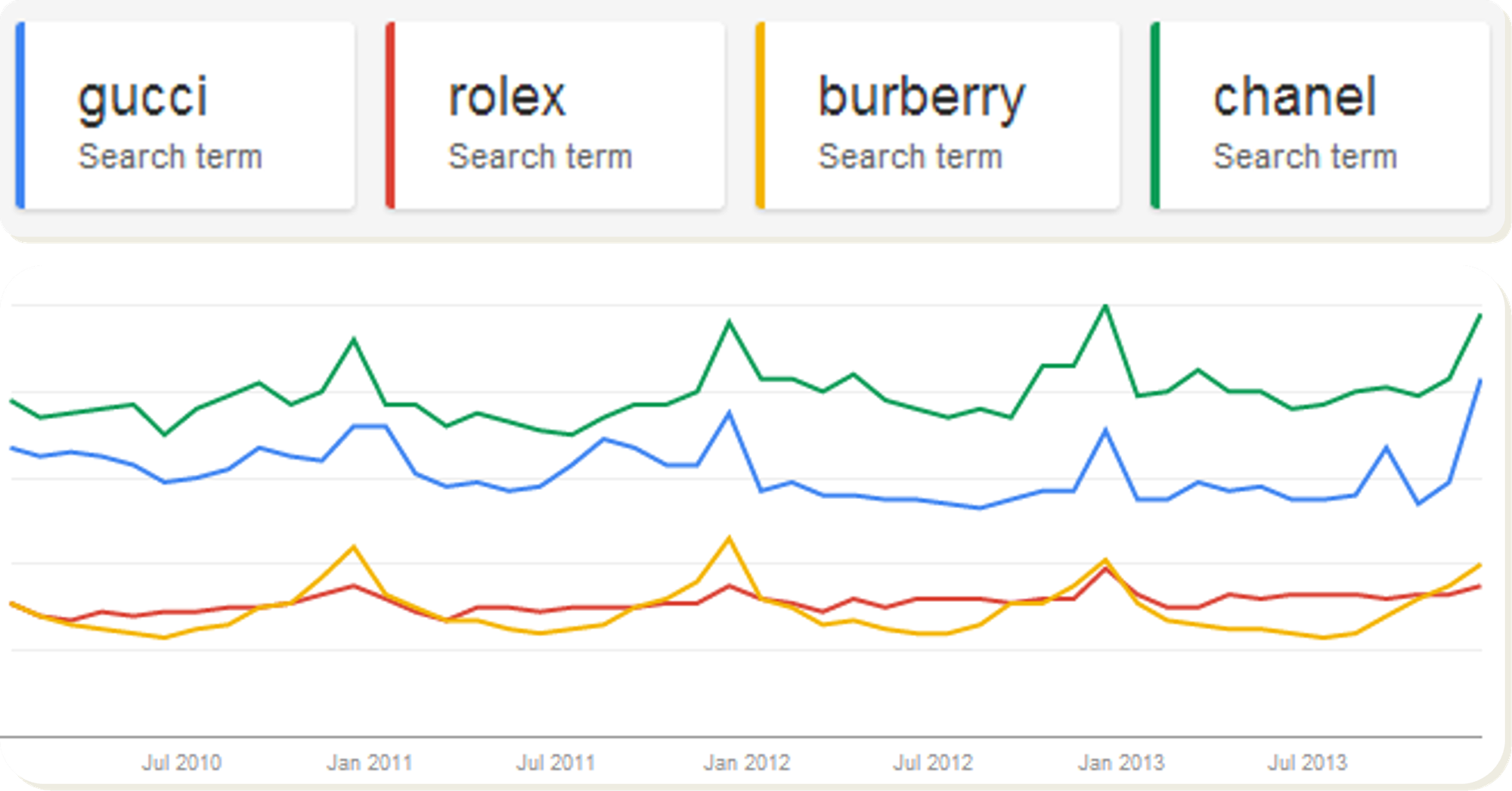
In short, this research that I conducted was to investigate the digital / search activities of luxury brands and their efforts to tackle the rise of digital & search engine marketing.
Methodology
This research is intended to identify the level of activity and usage of digital marketing particularly in Search Engine Marketing by luxury brands. Thus, this research aims to explore existing practices, contexts and scenarios of digital luxury marketing while identifying the challenges faced by the luxury industry. This qualitative and relevant information can be obtained merely from none other than the professionals at the luxury brands. A qualitative survey was targeted exclusively to Digital, Media, Advertising and Marketing professionals at luxury brands through personal messages and emails. The request for completing this survey was carefully crafted and qualitatively passed on to only 53 people, with each one of them representing one luxury brand. The total number of received responses was 32 which illustrates that there are 32 brands represented in the following market research conducted. The brands represented in this research are from the major luxury conglomerates such as LVMH, Richemont Group, Kering (formerly known as PPR), The Swatch Group, Volkswagen Group, Fiat Group, Starwood Hotels & Resorts Worldwide, InterContinental Hotels Group, Marriott International, Taj Hotels Resorts & Palaces along with many independent, well-known luxury brands from France, Switzerland and Italy.
Digital, Media, Advertising and Marketing professionals from Luxury Brands of the below conglomerates & multinational corporations participated in this research study. In addition, representatives from independent, well-known luxury brands from France, Switzerland and Italy also participated in this study.
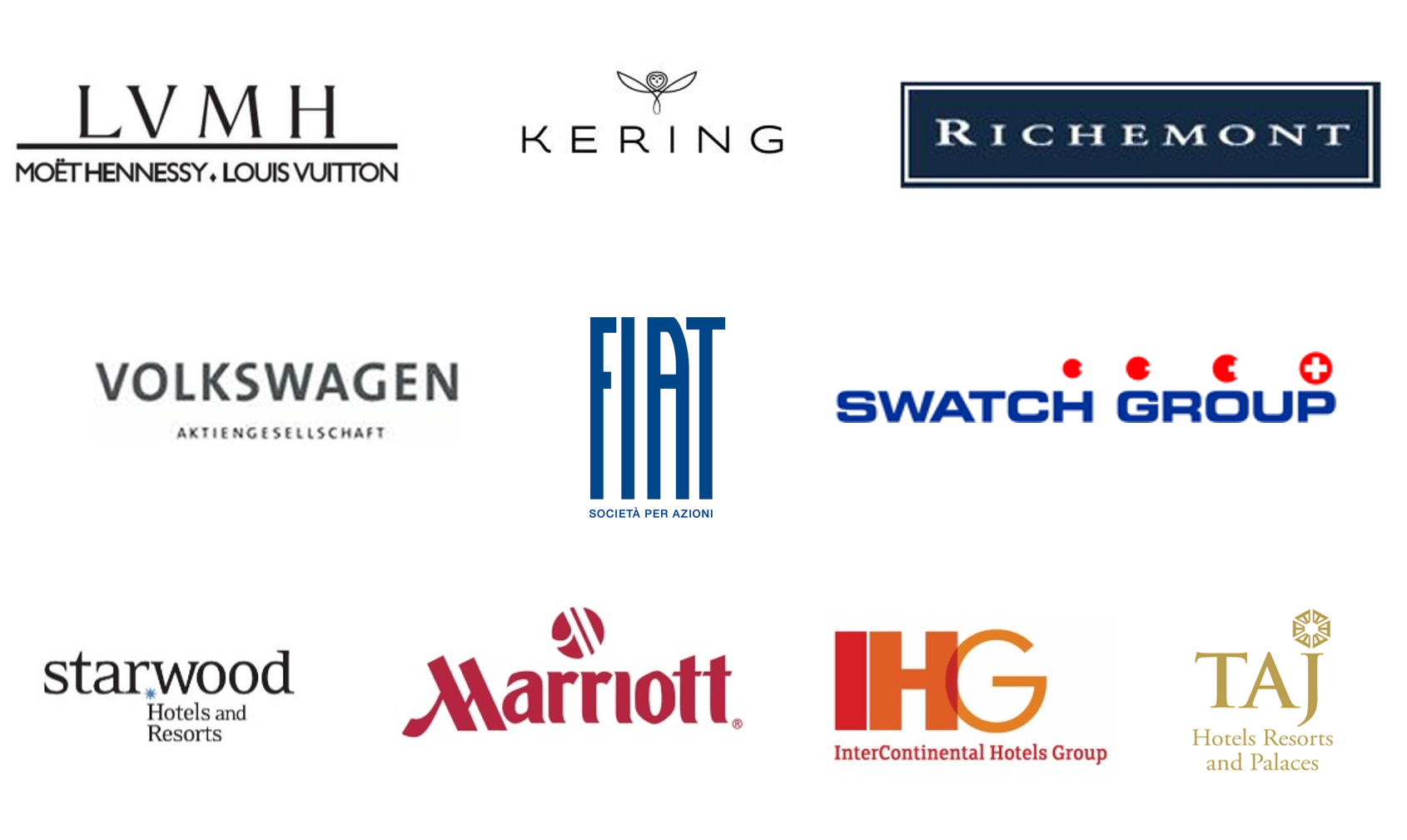
Display advertising is of priority for almost all luxury brands
Unsurprisingly, for digital luxury marketing, the results clearly illustrate that 97% of the luxury brands in this research were active in Display marketing while 94% of the luxury brands are active in Social Media Marketing, e-CRM and Website marketing. In regards to Search Engine Marketing, 88% of the luxury brands were active on SEO (organic search) while only 63% of the luxury brands were active on SEA (paid search).
“Which of the following digital marketing activities are luxury brands currently engaged in?”
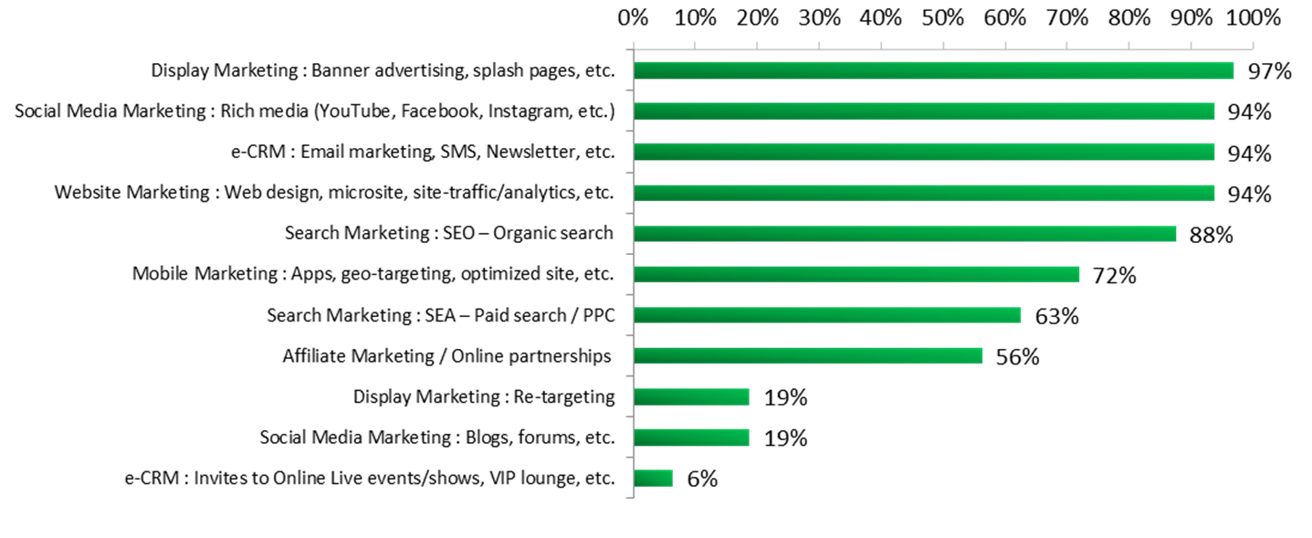
In contrast to the luxury brands’ level of activity in Search Engine Marketing, it can be identified that there are several competitors, ranging from retailers to online portals, already active on search engine results page (SERP) as shown in the example for the search query ‘buy burberry scarf”. SERP is an important touch point for a brand. Thus, it is vital for brands to react and adapt quickly to this radically changing marketplace.
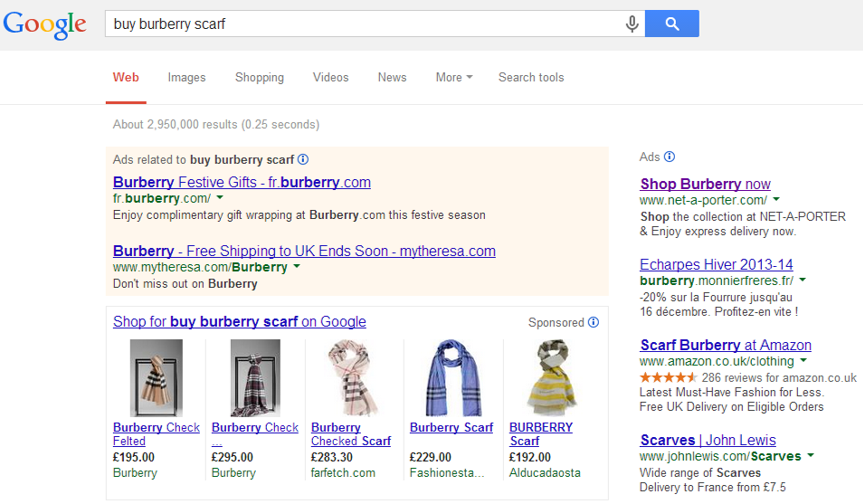
50% of luxury brands do not have E-Commerce websites. While in the remaining half who have E-Commerce enabled, 56% are not engaged in effective & holistic ROI practice
It is found that 50% of luxury brands do not have an e-commerce website. Only 22% of the luxury brands are effectively driving and managing e-commerce sales as they are actively measuring web traffic & analytics, ad metrics and sales volume. 19% of the luxury brands are assessing web traffic & analytics and sales volume while 9% of the luxury brands are only quantifying web traffic & analytics without ad metrics. This 28% of the luxury brands who have not included ad metrics for e-commerce management is a result of not having digital advertising for e-commerce-driven campaigns and/or not having integrated these ad metrics with the other parameters appropriately. This lack of integration should be a significant concern for these brands as it indicates that effective ROI exercises and optimizations are not in place.
“Do luxury brands have an E-commerce website in at least one country? If so, how do luxury brands measure its success, progress, KPI?”

The United States and Europe are the preferred market regions for digital marketing initiatives
28% of the luxury brands have indicated the USA as the most important region for digital marketing followed by 25% for Europe while 19% of the luxury brands focus on China. JAPAC region follows behind China with 13%. It is noteworthy to identify that 9% indicated Middle-East’s importance while 6% have Africa as their priority for digital marketing activities.
“What are luxury brands’ top priority country/regionThe for digital marketing initiatives?”
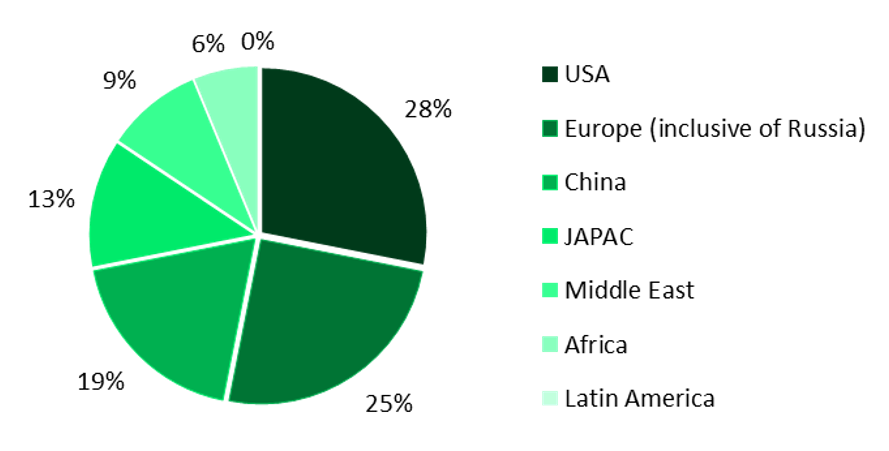
According to Bain & Company’s press release3, the 2013 estimated market revenues per region (as shown in the figure) illustrate that Europe and the Americas are key drivers of luxury goods revenue. Interestingly, the luxury brand’s digital market priority is not that far from the market revenue figures. This highlights that the luxury brands are up-to-date and are following the market trends.
Bain & Company's 2013 luxury goods market revenue estimate study
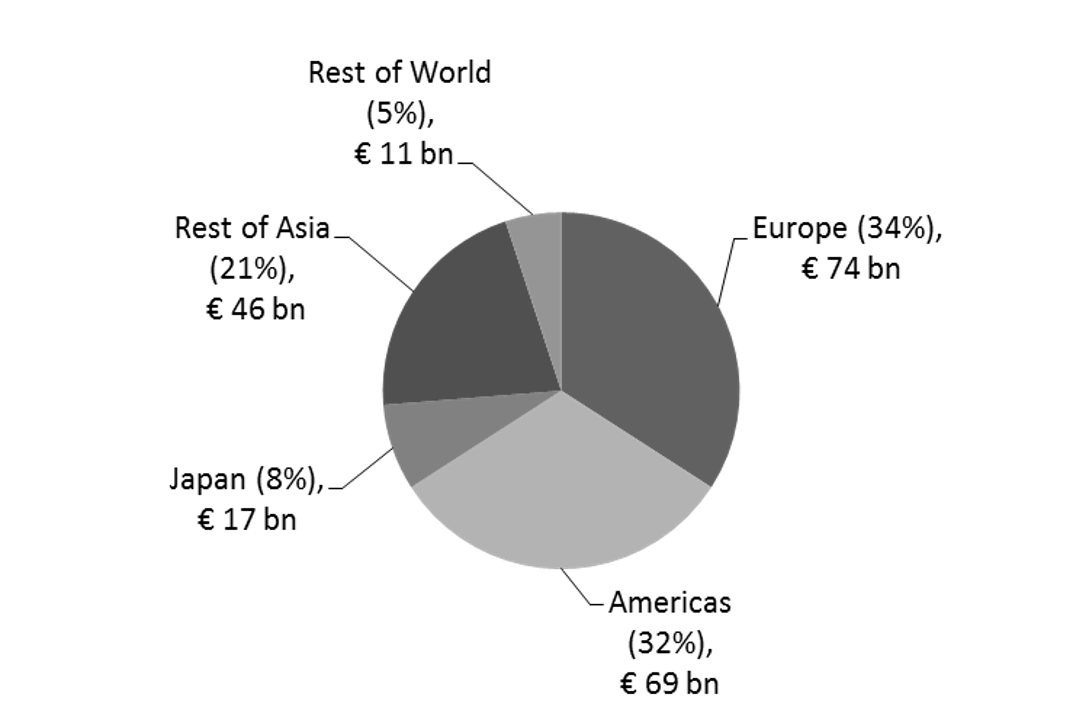
Luxury brands’ perspective of Search Engine Marketing is primarily to drive traffic to website or store
94% of the luxury brands agree that SEM leverages qualified traffic. However, only 19% of luxury brands agree that SEM provides an ROI strategy while only 13% of luxury brands agree that SEM can offer a branding strategy.
“If luxury brands decided to be active on Search Engine Marketing, what value does it bring for the brand & business?”

In a comparable market research conducted for Social Media Marketing by Luxury Interactive4, 48% of the luxury brands ranked “Driving Brand Engagement/ Loyalty” as their first objective of social media efforts while 30% of the brands ranked “Acquiring new customers” as their first objective for the same. In short, it can be articulated that luxury brands would like to prioritize their digital marketing objective to allure users to their store or website to showcase their luxurious experience as opposed to the often overlooked opportunity (examples showcased) of what this digital channel represents and its technological offering for both branding and driving sales strategy.
Gucci addresses queries user’s search queries and engages directly with an E-shopping experience

In contrast, Dior’s absence on SERP for a user’s search query results in retailers' and competitors’ profitability in sales and revenue

Budgets & Investment constraints in digital marketing emerge as a challenge for most of the luxury brands
78% of barriers luxury brands find budget & investment constraints as a challenge for digital marketing. 38% of the luxury brands have lack of resources in terms of technology, time and human capital while 19% of the luxury brands find legal issues as barriersbehaviour to digital marketing & SEM execution.
“Challenges luxury brands encounter during Digital Marketing (Search Engine Marketing) execution?”

Similarly, Economist Intelligence Unit5 report that marketers across all sectors and industries find that inadequate budgets for digital marketing and database management are the biggest obstacle in regard to digital marketing strategies. Many eMarketer reports highlight the media trends and share of media spending in each media channel. With this landscape in the background, it can be found across various discussion forums that the primary two reasons for budget constraints are: 1. lack of adopting the media investment spilt according to market and customer behaviourto trends and 2. inefficiency in budget management. According to Adobe & Google, digital analytics tools provide a holistic approach in identifying and optimizing budgets appropriately. Gartner, Inc. and many other digital experts underline the importance of budget allocations and recommend optimizing efforts in search, display, social, etc. accordingly.
1 Go-Gulf.com (2013): 'How people spend their time online', Nielsen & Comscoredatamine.com
2 PM Digital (2012): 'Trend Report: Luxury Brands Online'
3 Bain & Company (2013): 'Luxury Goods Worldwide Market Study'
4 Luxury Interactive (2013): 'The State of Luxury Digital Marketing'
5 Economist Intelligence Unit (2013): 'Mind the marketing gap'
